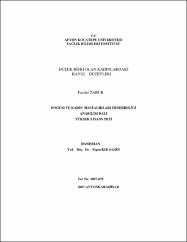Düşük riski olan kadınlardaki kaygı düzeyleri
Özet
Bu çalısma gebeligi risk altında olan kadınların duygu ve düsüncelerinin
arastırılması, kaygı düzeylerinin belirlenmesi amacıyla yapılmıstır.
Arastırmamızda, Temmuz 2007/Agustos 2007 tarihleri arasında
Afyonkarahisar Kocatepe Üniversitesi Ahmet Necdet Sezer Uygulama ve Arastırma
Hastanesi Kadın Hastalıkları ve Dogum Anabilim Dalı’na ve Afyonkarahisar
Zübeyde Hanım Dogum ve Çocuk Hastalıkları Hastanesi Kadın Dogum Bölümü’ne
basvuran gebelere ulasmak hedeflenmistir.
Çalısmamız düsük riski olan 50 gebe ve gebeligi normal devam eden 50 gebe
ile yapılmıstır. Çalısmamız arastırma grubu ve kontrol grubu olarak 2 grupta
incelenmistir. Arastırma grubundaki gebeler klinik olarak abortus imminens tanısı
almıs gebelerden, kontrol grubundaki gebeler ise gebeligi normal sekilde devam eden
gebelerden olusmaktadır. Çalısmamıza psikolojik problemleri ve sistemik hastalıgı
olan, sürekli ilaç kullanmak zorunda olan gebeler alınmamıstır.
Düsük riski olan grubun %94’ü, normal gebelerin %86’sı 19-34 yas
grubundadır. Gebelik haftaları düsük riski olan grupta ortalama 13,4±3,6, normal
gebelerde 13,5±3,0’dır. Her iki grubunda %84’ü ev hanımıdır. Grupların tamamı
evlidir.
Arastırmamızda veri toplama aracı olarak 40 sorudan olusan anket formu ile
grupların kaygı düzeylerini saptamak için Spielberger’in Durum-Sürekli Anksiyete
Envanteri (State Traid Anksiety Invantory) STAI form kullanılmıstır. STAI form
durumluluk ve süreklilik kaygı düzeyini yansıtmakta kullanılan 20’ser maddeden
olusan bir ölçektir. Anket formu kadınların demografik özellikleri, genel saglık
bilgileri, obstetrik özellikleri, gebelikle ilgili duygu ve düsünceleri, hastanedeki
durumlarıyla ilgili açık ve kapalı uçlu sorulardan olusmustur.
Elde edilen veriler, SPSS for Windows 11.5 ( Statistical Package for Social
Sciences for Windows ) paket programına kodlanarak girilmistir. statistiksel
analizlerde Pearson Ki-kare (X2) testi, ANOVA ve student t testi kullanılmıstır.
statistiksel anlamlılık p<0,05 ile tanımlanmıstır. Arastırmamızda düsük riski olan kadınların durumluluk ve süreklilik kaygı
puanlarının gebeligi normal devam eden kadınlara göre anlamlı olarak yüksek
oldugu saptanmıstır. Yine düsük riski olan grupta aile çevresinden destek alan
gebelerin durumluluk ve süreklilik kaygı puanları, saglık personelinden destek alan
gruba göre düsük bulunmustur. Bu da aile desteginin önemini ortaya çıkarmaktadır. The study has been made to search the feelings and thoughts of the women
who are under the risk of miscarriage and aims to point out their anxiety levels.
In this research the participants have been chosen among the pregnant
applicants of Afyonkarahisar Kocatepe University Ahmet Necdet Sezer Practice and
Research Hospital, Maternity Ward and Afyonkarahisar Zübeyde Hanım Child and
Maternity Hospital between July-August 2007.
The subjects of the research are; 50 women who had the risk of miscarriage
during their pregnancy and 50 women who had a normal pregnancy period. The
study is evaluated in two groups which are called "research" and "control" group.
The participants who had the risk of miscarriage in their pregnancy are
involved in the first, research group and the participants living a normal pregnancy
are observed in the second, control group. The pregnant ladies who have
psychological problems, periodic illness and obligation to a regular drug use have
been deliberately excluded from the survey.
%94 percent of the participants involved in the "research" group and %86 of
the candidates observed in the "control" group are between 19-34 age level. The
average of the pregnancy weeks in the potential miscarriage risk group is 13,4±3,6
and this rate is 13,5±3,0 for the normal pregnants' group. Also for both of the groups,
%84 of the participants are housewives and all of them have been married.
The survey consists of a questionnaire with 40 questions and a STAI
(State Traid Anxiety) form of Spielberger to figure out the groups' anxiety level and
collect data. STAI form is the measurement that involves 20 items in and used in
order to reflect the state, continuity of the participants' anxiety level.
Open and close-ended questions about women's demographic features, general
health datas, obstetric characteristics, feelings and thoughts on pregnancy and their
situation in the hospital are aimed in the survey form.Given information are analysed via SPSS for windows 11.5 (Statistical
Package for Social Sciences) programme Pearson's Chi-Square (X2) test, ANOVA
analysis and student t-test are applied. Statistical meaningfulness is assumed as
p<0,05.
In the research it's found out that; state and continuity anxiety scores of
women who have the potential risk of miscarriage have been considerably higher
compared to the women leading a normal pregnancy period. Also, State and
Continuity Anxiety Scores of the pregnants within the risk group of miscarriage,
who are supported by their families, have been lower than the scores of those who
are supported by health personnel. The result draws attention to the importance and
positive influence of the family support.
Bağlantı
http://hdl.handle.net/11630/3752Koleksiyonlar
- Yüksek Lisans Tezleri [667]



















